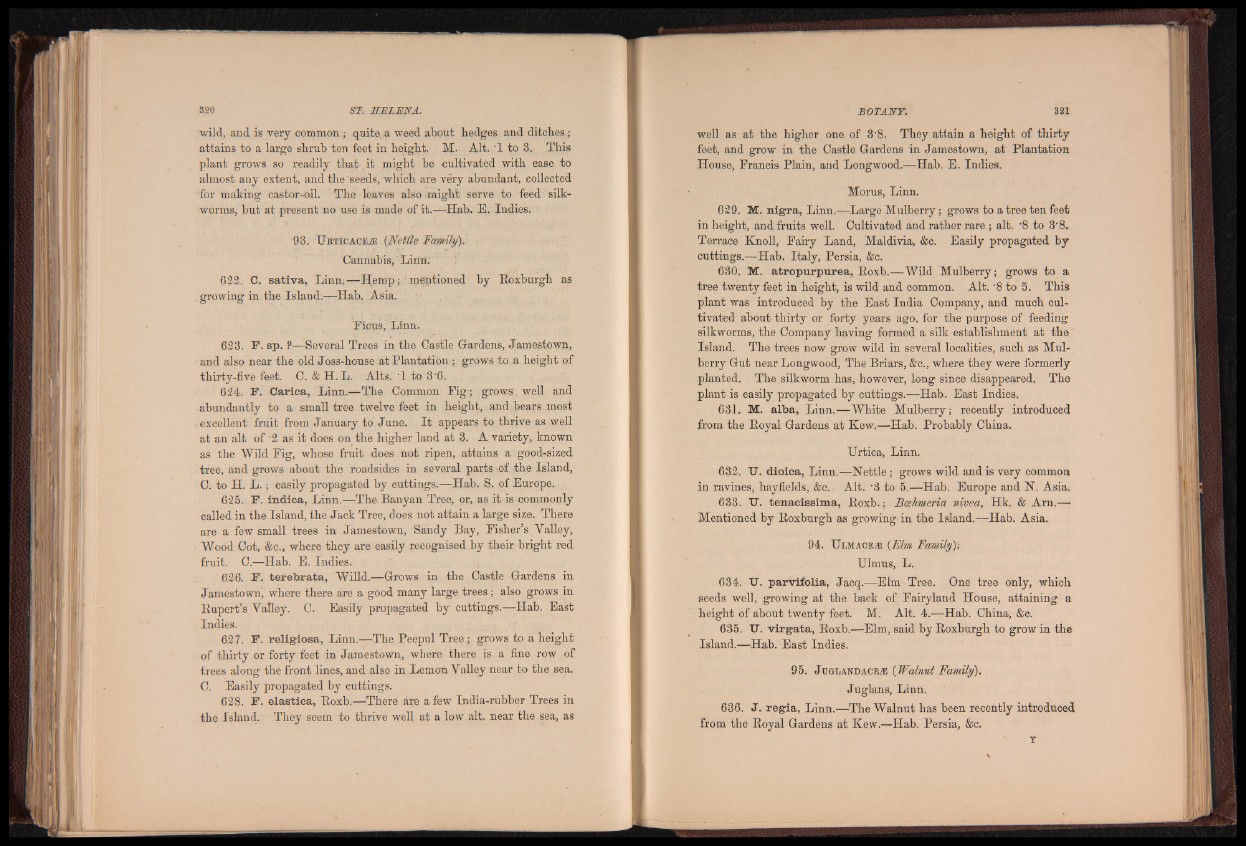
wild, and is very common ; quite a weed about hedges and ditches ;
attains to a large shrub ten feet in height. M. Alt, '1 to 3. This
plant grows so readily that it might be cultivated with ease to
almost any extent, and the ’seeds, which are very abundant, collected
for making castor-oil. The leaves also might serve to feed silkworms,
but at present no use is made of it.—Hab, E. Indies.
93. T J e t i c a c e . ® (Nettle Family).
Cannabis, f Liiln.
622. C. sativa, Linn,—Hemp; mentioned by Boxburgh as
growing in the Island:—Hab. Asia.
Ficus, Linn.
623. F. sp. P—Several Trees in the Castle Gardens, Jamestown,
and also near the old Joss-house at Plantation t grows to a height of
thirty-five feet. C. & H. L. Alts. T to 3‘6.
624. F. Carica, Linn.—’The Common Fig; grows well and
abundantly to a small tree twelve feet in height, and bears most
excellent fruit from January to June. I t appears to thrive as well
at an alt of ’2 as it does on the higher land at 3. A variety, known
as the Wild Fig, whose fruit does not ripen, attains a good-sized
tree, and grows about the roadsides in several parts of the Island,
C. to H. L . ; easily propagated by cuttings.—Hab. S. of Europe.
625. F. indica, Linn.—The Banyan Tree, or, as it is commonly
called in the Island, the Jack Tree, does not attain a large size- There
are a few small trees in Jamestown, Sandy Bay, Fisher’s Valley,
Wood Cot, &c., where they are easily recognised by their bright red
fruit. C.—Hab. E. Indies.
626. F. terebrata, Willd.—Grows in the Castle Gardens in
Jamestown, where there are a good many large trees; also grows in
Bupert’s Valley. C. Easily propagated by cuttings.—Hab. East
Indies.
627. F. religiosa, Linn.—The Peepul Tree; grows to a height
of thirty or forty feet in Jamestown, where there is a fine row of
trees along the front lines, and also in Lemoh Valley near to the sea.
C. Easily propagated by cuttings.
628. F. elástica, Boxb.—There áre a few India-rubber Trees in
the Island. They seem to thrive well at a low alt. near the sea, as
well as at the higher one of 3-8. They attain a height of thirty
feet, and grow in the Castle Gardens in Jamestown, at Plantation
House, Francis Plain, and Longwood.—Hab. E. Indies.
Morus, Linn.
629. M. nigra, Linn.—Large Mulberry; grows to a tree ten feet
in height, and fruits well. Cultivated and rather rare ; alt. -8 to 3‘8.
Terrace Knoll, Fairy Land, Maldivia, &c. Easily propagated by
cuttings.—Hab. Italy, Persia, &c.
630. M. atropurpurea, Boxb.—Wild Mulberry; grows to a
tree twenty feet in height, is wild and common. Alt. -8 to 5. This
plant was introduced by the East India Company, and much cultivated
about thirty or forty years ago, for the purpose of feeding
silkworms, the Company having formed a silk establishment at the
Island. The trees now grow wild in several localities, such as Mulberry
Gut near Longwood, The Briars, &c., where they were formerly
planted. The silkworm has, however, long since disappeared. The
plant is easily propagated by cuttings.—Hab. East Indies.
631. M. alba, Linn.—White Mulberry; recently introduced
from the Boyal Gardens at Kew.—Hab. Probably China.
Urtica, Linn.
632. IT. dioica, Linn.—Nettle; grows wild and is very common
in ravines, hayfields, &c. ■ Alt. -3 to 5.—Hab. Europe and N. Asia.
633. U. tenacissima, Boxb.; Bcehmeria nivea, Hk. & Am.—
Mentioned by Boxburgh as growing in the Island.—Hab. Asia.
94. U l m a c e /e {Elm Family):
Ulmus, L.
634. IT. parvifolia, Jacq.—Elm Tree. One tree only, which
seeds well, growing at the back of Fairyland House, attaining a
height of about twenty feet. M. Alt. 4.—Hab. China, &c.
635. IT. virgata, Boxb.—Elm, said by Boxburgh to grow in the
Island.—Hab. East Indies.
95. J u g l a n d a c e t E {Walnut Family).
Juglans, Linn.
636. J. regia, Linn.—The Walnut has been recently introduced
from the Royal Gardens at Kew.—Hab. Persia, &c.
Y